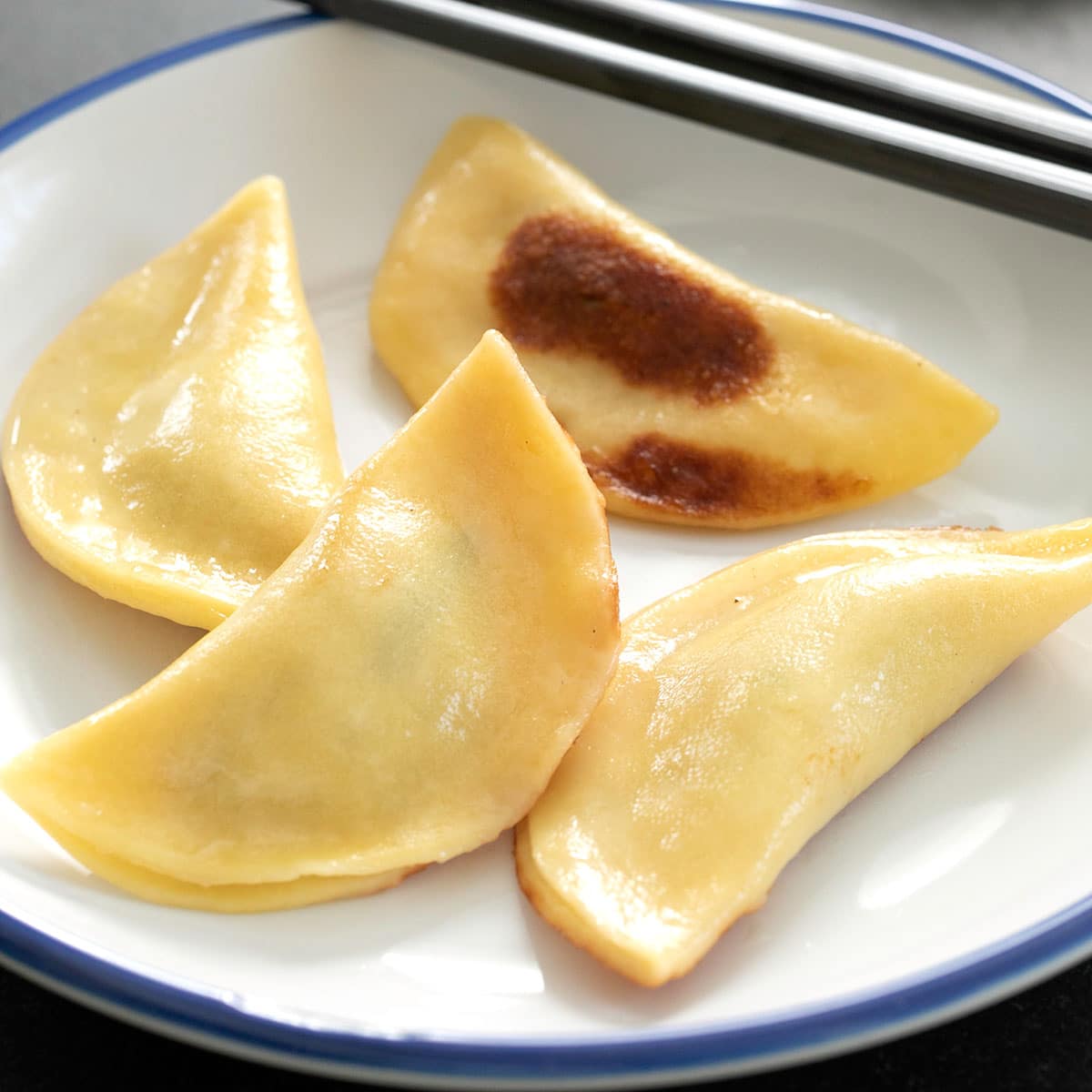

Gluten free potstickers made from homemade won ton wrappers and simple savory fillings taste like they came from your favorite restaurant. The secret's in the cooking method!

WANT TO SAVE THIS RECIPE?
The best method for making perfect gluten free potstickers
It's all about the texture of the wrappers and filling
Good potstickers or any dumplings, really, are all about the texture. The filling should be pleasantly savory, but you can get that in a meatball. The potsticker's claim to fame is the crisp-tender texture of the wrapper.
You can make a tender won ton wrapper by boiling it or sautéeing it. But the way to get it to be crisp and tender is by starting with the sauté, and following it with steaming. And it can all be done in the same skillet.
It's best to use a cast iron skillet since it gets so hot and retains that heat without a very high flame. But any heavy-bottom sauté pan with a tight-fitting lid will work.

How to create that crisp-tender texture in your gf potstickers
Heat just a couple tablespoons of a neutral oil until rippling, which is just when you see ripples where the light hits the oil in the hot pan. Add the formed, raw potstickers to the hot pan in a single layer, and allow them to brown on the underside. It won't take much more than a minute.
The next step is to add just enough water to the hot pan to steam the potstickers with the lid on, and then evaporate after removing the lid. Be sure to work quickly to avoid splattering oil that comes from adding water to hot oil.
During 5 or 6 minutes that the potstickers are in the pan with water, covered with the lid, the filling and the rest of the won ton wrapper will cook to perfection. Remove the lid, and restore any crispness that was lost during steaming.
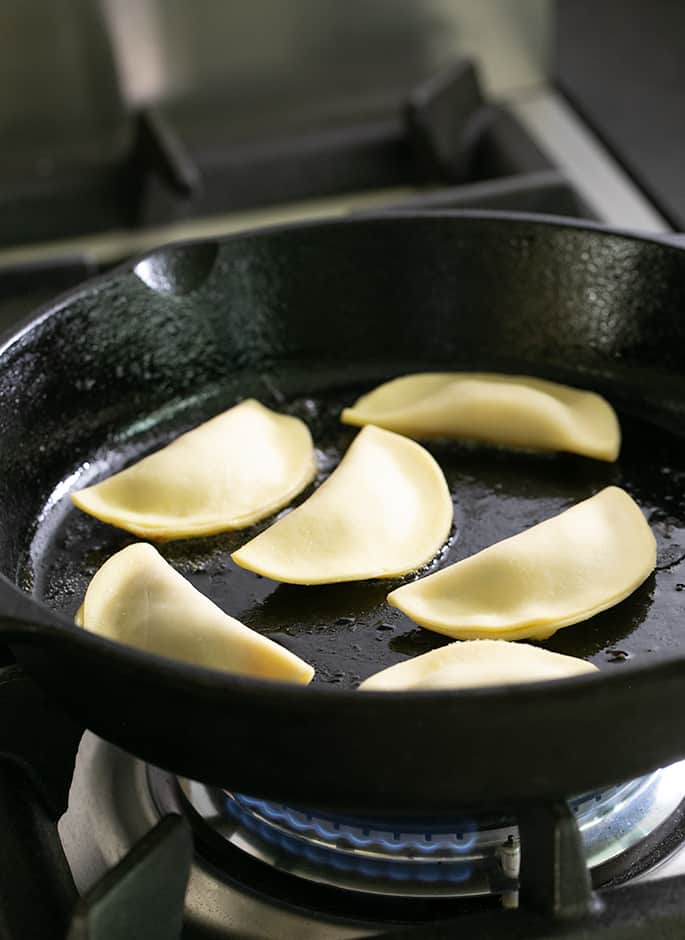
Making the gluten free won ton wrappers ahead
It is nothing short of a labor of love to make these gluten free potstickers. Even if you could buy gluten free won ton wrappers in a ready-made package (please, maybe one day ??), it would still take time to fill, shape, and cook them.
The time it takes to make the wrappers, though, is what might scare you away from ever attempting this recipe, though. I don't have a solution, but I have a coping technique: make the wrappers days (or even weeks) ahead of time.
You can make the gluten free wonton wrappers according to the recipe instructions, pile them up, wrap them very tightly and place them in the refrigerator. They will keep that way for at least a week.
For longer storage, you can freeze them. They may become a bit icy, since they are a tiny bit moist to the touch when fresh.
But if you wrap them very tightly, you can keep them there for a couple months. Before working with them, defrost them overnight in the refrigerator, and allow them to come to cool room temperature before using them in a recipe.
Make the gf potstickers ahead
If you'd like to make the potstickers themselves ahead of time, I support your good decision-making! Just form them completely and freeze in a single layer on a baking sheet.
Once they've frozen solid, pile them into a tightly sealed bag. Defrost in the refrigerator before cooking, and proceed with the recipe as written. You'll be so happy you did!
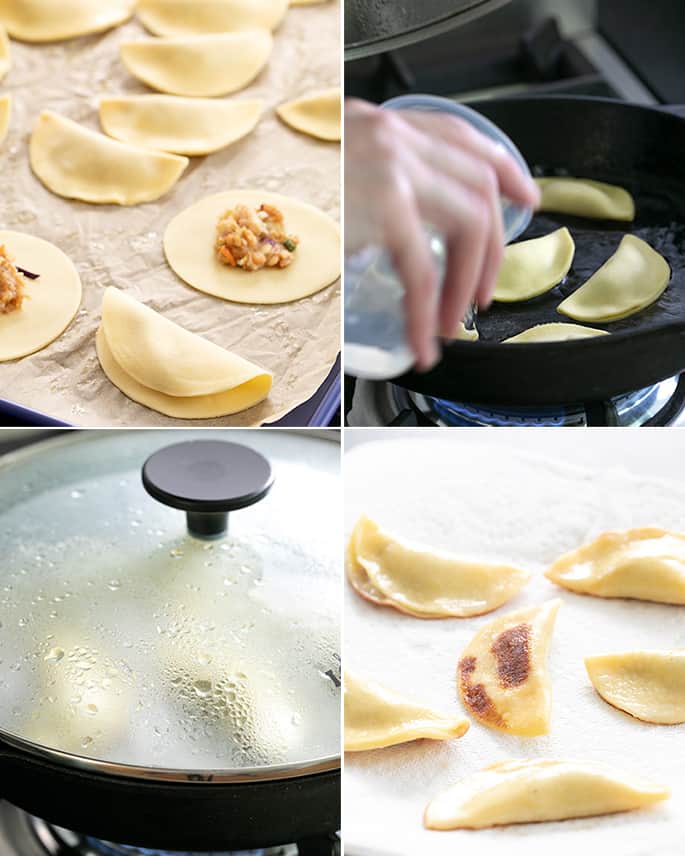
Gluten free potstickers: Ingredients and substitutions
Can you make gluten free, egg free potstickers?
The eggs are the absolute most difficult thing to replace in the recipe for gluten free won ton wrappers. You can change up the filling any which way, and even use water in place of the egg wash to seal the potstickers.
But replacing the eggs in the won ton wrapper recipe is not something I know how to do. The recipe is so incredibly simple, composed of little more than gluten free flour, eggs, and water.
The eggs provide structure and bind the ingredients together. You may be able to replace the eggs with a combination cornstarch slurry and additional xanthan gum, but it would require some serious experimentation. I'm working on it!
Can you make gluten free potstickers without meat?
Yes! If you'd like to make these with an alternate filling, there are plenty of options. You can replace the ground chicken or pork with a combination of the two, or a combination of chopped, raw shrimp and either ground chicken or pork.
You could also make the filling with crumbled tofu in place of the ground meat, but you'll need an additional binder. Adding some beaten egg to the filling might work.
Gluten free, soy free potstickers
Both gluten free soy sauce and tamari are soybean-based. If you can't have soy, try using Coconut Secret coconut aminos, which is soy free.
Coconut aminos sauce tends to be a bit sweeter, so it's not a perfect substitute but it does provide that umami flavor we're looking for. Bragg's brand liquid aminos contains soy, so it's a soy sauce alternative but not one that is soy-free.
How to make authentic gluten free potstickers, step by step
Gluten Free Potstickers Recipe
Ingredients
- 1 recipe gluten free Won Ton Wrappers
- ¼ cup tamari or gluten free soy sauce plus more for serving
- 1 teaspoon toasted sesame oil
- 1 tablespoon freshly grated ginger or use 1 1/2 teaspoons ground
- ¼ cup chopped fresh or freeze-dried scallions/green onions white and green parts
- 1 cup finely chopped raw cabbage
- 1 pound ground chicken or pork
- Egg wash 1 egg beaten with 1 tablespoon water
- 4 tablespoons (56 g) neutral oil (like grapeseed, canola, peanut, or vegetable oil) plus more as necessary, for sautéing
- Lukewarm water for cooking
Instructions
Make the won ton wrappers.
- Prepare the won ton wrappers according to the recipe instructions, shaping them into rounds about 3-inches in diameter.
Make the filling.
- In a medium-size bowl, place the tamari or soy sauce, sesame oil, ginger, and scallions, and mix to combine well. Add the cabbage, and mix again to combine. Add the ground chicken or pork, and mix gently to combine.
Fill and shape the potstickers.
- Arrange the prepared won ton wrappers on a flat, lined surface (plastic wrap or parchment paper on a rimmed baking sheet works well), and place about 1 tablespoon of the filling in the center of each wrapper.
- Using a pastry brush, brush the edges of each wrapper lightly with the egg wash, then fold the wrapper over on itself to cover the filling.
- Pinch the edges to seal the dumpling closed, gently pressing out any trapped air as you go. (See Recipe Notes for make-ahead instructions.)
Cook the potstickers.
- To a large, heavy-bottomed skillet over medium-high heat, heat about 2 tablespoons of the neutral oil until rippling. Place as many dumplings as will fit comfortably in a single layer in the hot oil.
- Sauté until the potstickers are golden and crisp on the underside, about 1 minute.
- Working quickly, add about 1/4 cup of lukewarm water to the hot pan, or enough so that it rises about 1/4 of the way up the side of the potstickers and cover the pan immediately. Allow the dumplings to continue to cook for about 5 minutes, or until they’re cooked through.
- Uncover the skillet, and continue to cook until the water has evaporated by about half and the dumplings are crisp-tender (about another minute). Remove them from the pan to a paper towel-lined plate, and repeat with the remaining potstickers.
- Serve immediately, with more tamari for dipping.
Notes
WANT TO SAVE THIS RECIPE?


Thanks for stopping by!
Hi, I’m Nicole. I create gluten free recipes that really work and taste as good as you remember. No more making separate meals when someone is GF, or buying packaged foods that aren’t good enough to justify the price. At Gluten Free on a Shoestring, “good, for gluten free” just isn’t good enough! Come visit my bio!
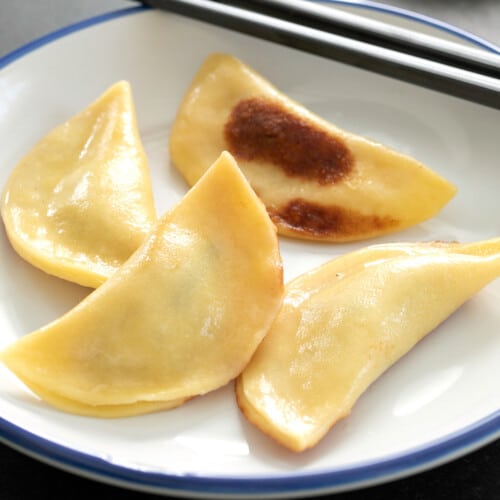
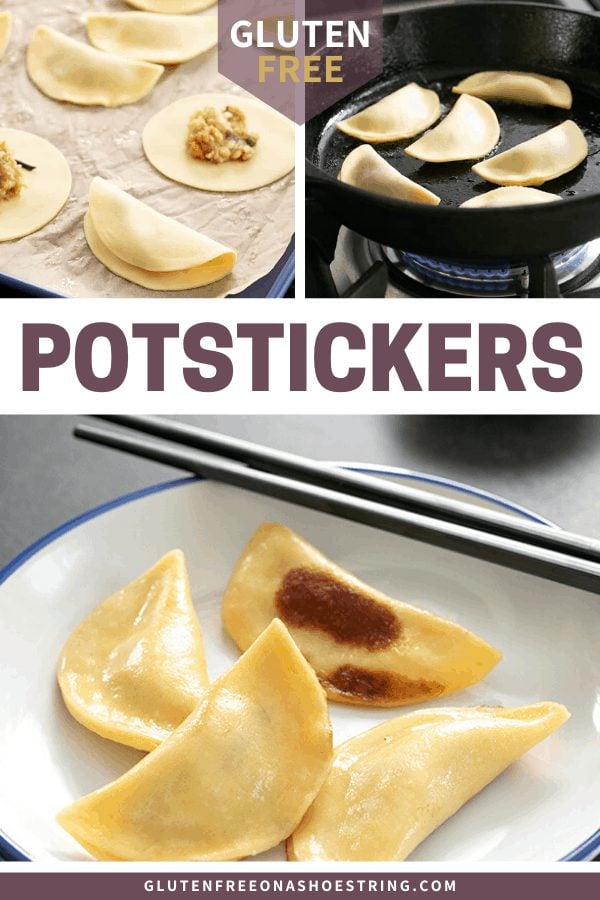

Christina says
Do you cook the chicken and pork first?
Nicole Hunn says
Nope. I would specify that, Christina!
Robin says
OOH! Thank you!! I have been gf for a little over two years, and I live in China. To say I have “missed” jiaozi (as potstickers are called in Chinese) is a major understatement.
There is a steamed bun that I miss with all my heart. Do you happen to have a recipe for something like that or suggestions at least for flours that can be steamed? They are called “mantou” in Chinese.
Nicole Hunn says
Actually, yes, Robin! I do have a recipe for Chinese steamed buns. They require some special flours that I’m not sure you can get, though. But if you can at all, they’re so worth it!!
Heidi says
Hi, Nicole. I can’t wait to try these. Which of your dough recipes would you recommend for chicken pillows (basically a substitute for crescent roll dough)? Would you try something like your potsticker dough or your puff pastry? (I’m headed to look at your puff pastry dough now. So if you’ve already answered this question there, don’t waste your time answering this. If the answer is in that post, I’ll find it. Thanks!
Nicole Hunn says
I’m afraid I don’t know what you mean by chicken pillows, Heidi. Perhaps you mean something like these handheld chicken pot pies?
Laura Corkill says
When I saw the photo, I thought, OOH pierogies! I’m not a pot sticker fan but thought that these wrappers might be perfect for my favorite Polish pasta dish.
Nicole Hunn says
I have a recipe for pierogies on the blog, Laura. Just use the search function!
Rachel says
Nicole, these are amazing. I used your Mock Better Batter recipe for the flour, as we don’t have that brand of flour in Australia. My celiac daughter said “Mum these are amazing”. No leftovers at our house!
Nicole Hunn says
Woohoo, Rachel! I’m so glad you were able to find the ingredients for the mock Better Batter. It’s there for that reason, when you can’t get one of my recommended blends. Sounds like you were a superhero mom right there. :)
Julie L says
Nicole, do you have a recommendation for freezing the prepared, uncooked pot stickers? When I was a teen working at a Chinese restaurant we’d make these by the hundreds during slow times and freeze them. The owners claimed that freezing them first was their secret to the amazing texture. I’d like to give it a go.
Thanks for the recipes! :)
Nicole Hunn says
Yes yes, Julie, definitely. I actually answered this on Facebook and will put a comment in the recipe itself, too. You can form them completely and freeze in a single layer on a baking sheet, then pile them into a tightly sealed bag. Defrost in the refrigerator before cooking, and proceed with the recipe as written!